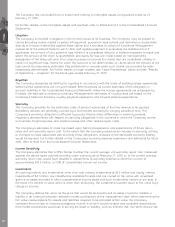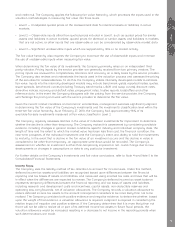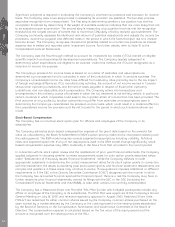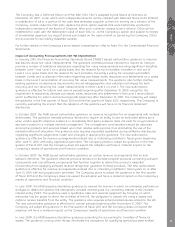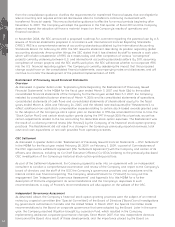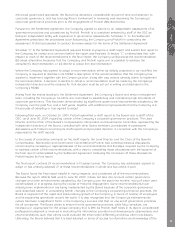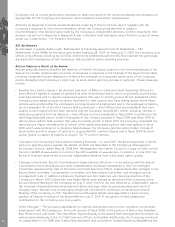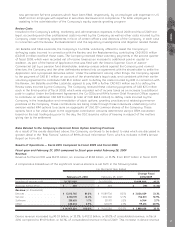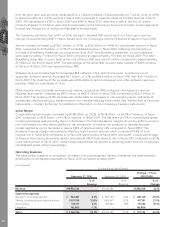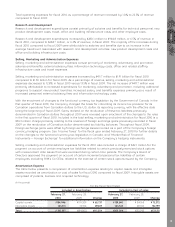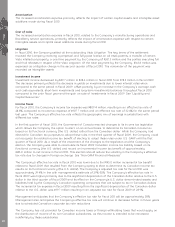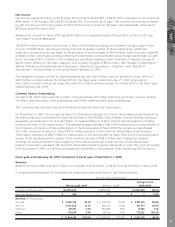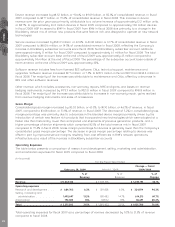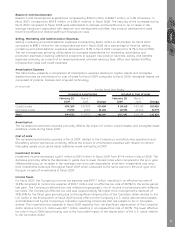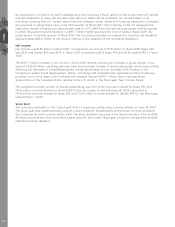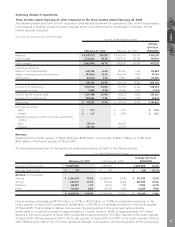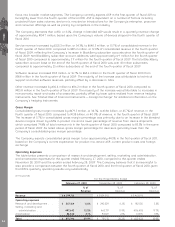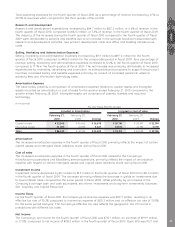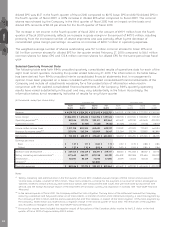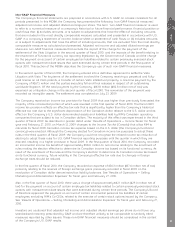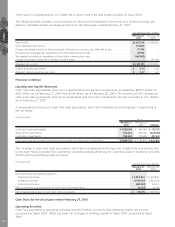Blackberry 2010 Annual Report Download - page 28
Download and view the complete annual report
Please find page 28 of the 2010 Blackberry annual report below. You can navigate through the pages in the report by either clicking on the pages listed below, or by using the keyword search tool below to find specific information within the annual report.
Amortization
The increased amortization expense primarily reflects the impact of certain capital assets and intangible asset
additions made during fiscal 2010.
Cost of sales
The increased amortization expense in fiscal 2010, related to the Company’s manufacturing operations and
BlackBerry service operations, primarily reflects the impact of amortization expense with respect to certain
intangible assets and capital asset additions made during fiscal 2010.
Litigation
In fiscal 2010, the Company settled all the outstanding Visto Litigation. The key terms of the settlement
involved the Company receiving a perpetual and fully-paid license on all Visto patents, a transfer of certain
Visto intellectual property, a one-time payment by the Company of $267.5 million and the parties executing full
and final releases in respect of the Visto Litigation. Of the total payment by the Company, $163.8 million was
expensed as a litigation charge in the second quarter of fiscal 2010. The remainder of the payment was
recorded as intangible assets.
Investment Income
Investment income decreased by $49.7 million to $28.6 million in fiscal 2010 from $78.3 million in fiscal 2009.
The decrease primarily reflects the decrease in yields on investments due to lower interest rates when
compared to the same period in fiscal 2009, offset partially by an increase in the Company’s average cash
and cash equivalents, short-term investments and long-term investments balances throughout fiscal 2010
compared to the prior fiscal year and the gain on sale of investments in fiscal 2009. See “Liquidity and
Capital Resources”.
Income Taxes
For fiscal 2010, the Company’s income tax expense was $809.4 million, resulting in an effective tax rate of
24.8% compared to income tax expense of $907.7 million and an effective tax rate of 32.4% for the same period
last year. The Company’s effective tax rate reflects the geographic mix of earnings in jurisdictions with
different tax rates.
In the first quarter of fiscal 2010, the Government of Canada enacted changes to its income tax legislation
which allows the Company the option to elect, on an annual basis, to determine its Canadian income tax
based on its functional currency (the U.S. dollar) rather than the Canadian dollar. While the Company had
elected for Canadian tax purposes to adopt these rules in the third quarter of fiscal 2009, the Company could
not recognize the related income tax benefit of electing to adopt these rules under U.S. GAAP until the first
quarter of fiscal 2010. As a result of the enactment of the changes to the legislation and the Company’s
election, the Company was able to recalculate its fiscal 2009 Canadian income tax liability based on its
functional currency (the U.S. dollar) and record an incremental income tax benefit of approximately
$145.0 million to net income in fiscal 2010. This election should reduce the volatility in the Company’s effective
tax rate due to changes in foreign exchange. See “Non-GAAP Financial Measures”.
The Company’s effective tax rate in fiscal 2010 was lower due to the $145.0 million incremental tax benefit
related to fiscal 2009 that resulted from the Company opting to elect to determine its Canadian income tax
results on its functional currency (the U.S. dollar). The Company’s adjusted tax rate for fiscal 2010 was
approximately 29.4% in line with management’s estimate of 29%-30%. The Company’s effective tax rate in
fiscal 2009 was higher primarily due to the significant depreciation of the Canadian dollar relative to the U.S.
dollar in the third quarter of fiscal 2009 and its effect on the Company’s U.S. dollar denominated assets and
liabilities held by the Company’s Canadian operating companies that are subject to tax in Canadian dollars.
The incremental tax expense in fiscal 2009 resulting from the significant depreciation of the Canadian dollar
relative to the U.S. dollar was $99.7 million resulting in an adjusted tax rate for fiscal 2009 of 28.9%.
Management anticipates that the Company’s effective tax rate for fiscal 2011 will be approximately 28%.
Management also anticipates the Company’s effective tax rate will continue to decrease further in future years
due to scheduled Canadian corporate tax rate reductions.
The Company has not provided for Canadian income taxes or foreign withholding taxes that would apply on
the distribution of income of its non-Canadian subsidiaries, as this income is intended to be reinvested
indefinitely by these subsidiaries.
MD&A
20


